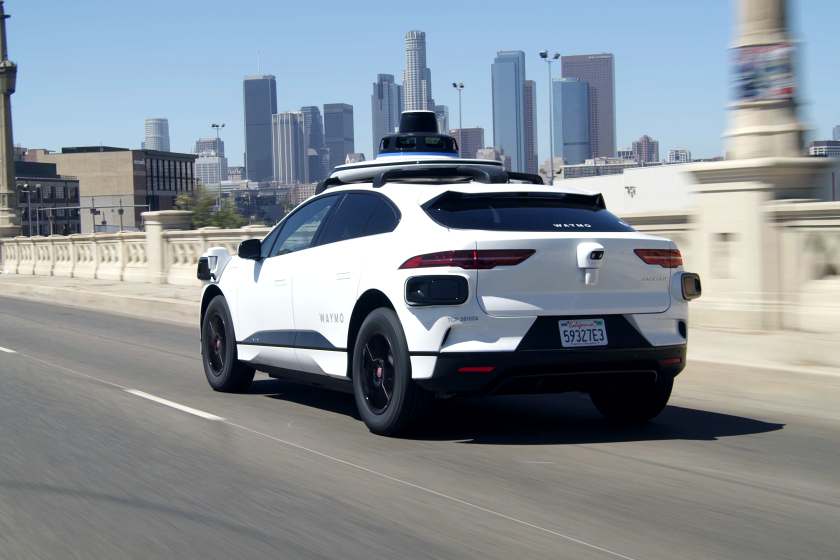Amazon’s robotaxi effort will begin testing in Los Angeles

- Share via
Zoox, the autonomous driving technology company owned by Amazon, is preparing to begin testing its vehicles in Los Angeles this summer.
The city will be the sixth testing location for the Bay Area-based venture, which does not yet offer rides to the public.
Founded in 2014 and acquired by Amazon in 2020, Zoox is one of several efforts to bring self-driving technology into the mainstream.
Tesla Chief Executive Elon Musk has been touting the potential of autonomous driving for years, and Waymo, owned by Google parent company Alphabet, is already operating driverless taxis in multiple cities including Los Angeles, San Francisco and Phoenix.
Zoox’s testing in Los Angeles will lay the groundwork for future commercial service, a company spokesperson said. The company plans to welcome its first public riders in Las Vegas and San Francisco by the end of the year.
“We’re going to keep moving towards self-driving tech and it’s not always going to be this obscure enigma that’s only available in a few places,” said Karl Brauer, an analyst at iSeeCars.com. “Amazon wants to start to have the technology in place to take advantage as the capabilities roll out.”
The self-driving taxi company Waymo launched in Los Angeles in November, bringing roughly 100 autonomous vehicles to neighborhoods from Santa Monica to West Hollywood.
What will Zoox testing look like in Los Angeles?
Zoox will deploy a small number of retrofitted Toyota Highlander test vehicles in Los Angeles, all with human safety drivers, the company said. The SUVs will operate in a limited area within the city, though the company has not disclosed specific routes or geographical boundaries.
As is standard when driving in a new city, the test fleet will complete manual mapping missions to identify challenging routes and road features specific to Los Angeles. Commercial service in the city is still far off and will require regulatory approval.
“Even when the technology is theoretically ready, the regulations and the approval processes are still going to be restricting,” Brauer said.
Zoox will not offer the public rides in its test vehicles or operate them without a human driver, the company’s website says. The company plans to eventually offer an on-demand ride-hailing service using purpose-built autonomous vehicles with no steering wheel and bidirectional capability.
How do Zoox vehicles work?
Zoox’s test vehicles are retrofitted SUVs, but the company is also developing a pill-shaped driverless vehicle that’s meant to be “closer to a living room on wheels than a traditional automobile interior,” the Zoox website says.
The robotaxis will be equipped with sensors and a type of laser-based radar called lidar that enables them to navigate dense urban areas, according to the company. Unlike Waymo vehicles, the taxis will have no driver’s seat or gas pedal.
The vehicles will be equipped with sliding doors and large windows, the spokesperson said, and the seats for passengers will face each other.
Angelenos can hail a robotaxi with the Waymo One app starting Tuesday. There are about 100 taxis in the Los Angeles fleet — but they don’t drive freeways.
Are the vehicles safe?
For the record:
2:28 p.m. April 15, 2025An earlier version of this story incorrectly stated that Zoox’s pill-shaped robotaxis have not been tested on public roads. The robotaxis have been testing on public roads since 2023 in San Francisco, Foster City and Las Vegas.
Zoox vehicles are built to prevent collisions and protect passengers in the event of an unavoidable accident, the company’s website says. The vehicles feature more than 100 safety innovations that don’t exist in traditional cars, according to the company.
The pill-shaped robotaxis are not yet ready for commercial service, but they have been testing on public roads in San Francisco, Foster City and Las Vegas since 2023.
Data suggest that automated driving could be safer than traditional driving. The insurer Swiss Re found that Waymo vehicles are safer than those with human drivers, but Zoox’s technology is not identical.
Both Teslas in Full Self-Driving mode and Waymo vehicles operating without a driver have been involved in accidents and collisions, generating doubt about the safety of self-driving technology. Waymo customers have reported various glitches on social media, including one Reddit user who posted a video of a Waymo driving the wrong direction into oncoming traffic.
Based on data collected by Waymo, its driverless vehicles had 81% fewer airbag deployment crashes, 78% fewer injury-causing crashes and 62% fewer police-reported crashes than traditional vehicles driving the same distance.
What is Amazon planning to do with self-driving technology?
Amazon acquired Zoox five years ago as a wholly owned subsidiary for more than $1.2 billion.
Zoox is aiming to launch a commercial ride-hailing service similar to Uber and Lyft that relies on its purpose-built bidirectional vehicles. But Amazon may have other ideas for the future of autonomous driving, Brauer said. The e-commerce giant could use driverless vehicles to make deliveries, for example, saving money and resources.
“Self-driving tech is a massive change, and if you’re a company like Amazon, you’ve got to be involved in it as quickly as possible,” Brauer said. “Whether it’s moving people or cargo or other things we can’t even conceive yet, Amazon doesn’t want to be caught flat-footed.”
More to Read
Inside the business of entertainment
The Wide Shot brings you news, analysis and insights on everything from streaming wars to production — and what it all means for the future.
You may occasionally receive promotional content from the Los Angeles Times.














